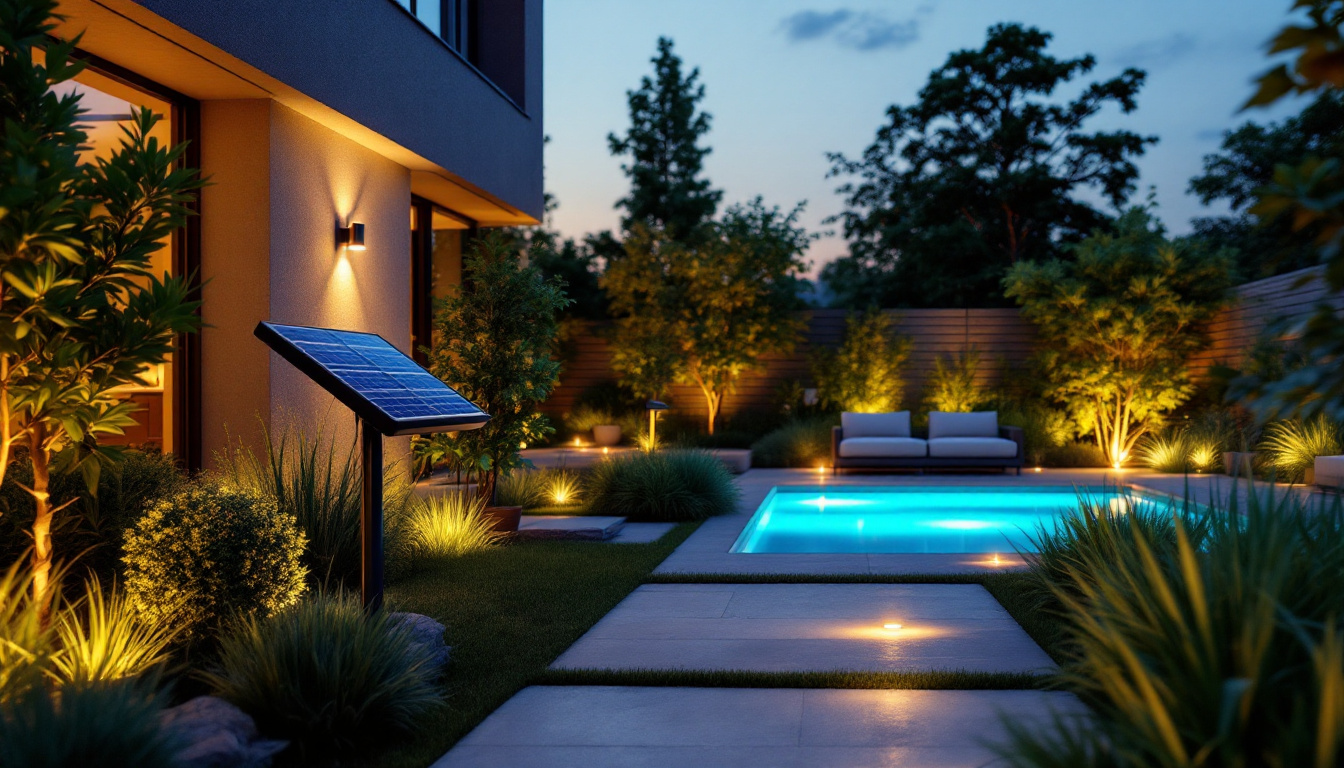
As the demand for sustainable and energy-efficient solutions continues to rise, solar lighting has emerged as a popular choice for illuminating walkways. For lighting contractors, mastering the installation and maintenance of bright solar lights can significantly enhance the quality of their services. This article will explore essential tips and best practices for effectively utilizing solar lights in walkway projects.
Before diving into installation techniques, it is crucial for lighting contractors to grasp the fundamentals of solar lighting technology. Solar lights operate by converting sunlight into electricity, which powers LED bulbs during the night. This process not only reduces energy costs but also minimizes the environmental impact associated with traditional lighting systems. By harnessing renewable energy, solar lighting contributes to a sustainable future, making it an attractive option for eco-conscious consumers and businesses alike.
Moreover, advancements in solar technology have significantly improved the efficiency and performance of solar lights. Modern solar panels are designed to capture a broader spectrum of sunlight, enabling them to generate electricity even on cloudy days. Additionally, innovations in battery technology allow for longer storage times, ensuring that solar lights remain operational throughout the night, even in less-than-ideal weather conditions. These improvements have made solar lighting a reliable choice for various applications, from residential gardens to commercial properties.
Solar lights typically consist of several key components: solar panels, batteries, LED bulbs, and sensors. The solar panels collect sunlight and convert it into electrical energy. The batteries store this energy for use during nighttime. LED bulbs are known for their longevity and energy efficiency, while sensors help automate the lighting system by detecting ambient light levels. Additionally, some solar lights come equipped with motion sensors, which can enhance security by activating lights when movement is detected, providing both illumination and peace of mind for property owners.
Furthermore, the integration of smart technology into solar lighting systems is becoming increasingly popular. Many modern solar lights can be controlled via mobile apps, allowing users to adjust brightness levels, set timers, and monitor battery status remotely. This level of customization not only enhances user experience but also maximizes energy efficiency, as users can tailor their lighting needs according to specific times and events. As technology continues to evolve, the functionality of solar lighting is expected to expand even further.
There are various types of solar lights available for walkway applications, including pathway lights, floodlights, and wall-mounted fixtures. Pathway lights are designed to line walkways, providing a soft glow that enhances visibility and safety. Floodlights can illuminate larger areas, making them suitable for expansive pathways or outdoor events. Wall-mounted fixtures are ideal for vertical surfaces, offering a stylish way to light up entrances and exits. These diverse options allow for creative landscaping and design, enabling homeowners and businesses to achieve their desired aesthetic while improving safety.
In addition to these common types, solar lights also come in decorative forms, such as string lights and lanterns, which can add a charming touch to outdoor spaces. String lights are perfect for patios and gardens, creating a cozy atmosphere for gatherings or quiet evenings outdoors. Lantern-style solar lights can be used as both functional lighting and decorative elements, often featuring intricate designs that enhance the visual appeal of outdoor settings. With such a wide variety of solar lighting options available, it is easier than ever for consumers to find solutions that meet their specific needs and preferences, all while contributing to a greener planet.
Selecting the appropriate solar lights for a specific walkway project involves considering several factors, including brightness, design, and functionality. Lighting contractors should be equipped to guide their clients through the decision-making process to ensure satisfaction.
The brightness of solar lights is measured in lumens. For walkways, a range of 100 to 300 lumens is generally sufficient to provide adequate illumination without being overly harsh. It is essential to assess the specific needs of the walkway, taking into account factors such as the surrounding environment and the intended use of the space.
Solar lights come in various designs, from sleek modern styles to more traditional looks. The choice of design should complement the overall aesthetic of the property. Contractors should encourage clients to consider how the lights will fit into the landscape and architecture, ensuring a cohesive appearance that enhances the outdoor space.
Modern solar lights often come equipped with additional features that enhance their functionality. Motion sensors, for example, can provide extra security by illuminating pathways when movement is detected. Dusk-to-dawn sensors automatically turn the lights on at sunset and off at sunrise, ensuring that the lights operate efficiently without manual intervention. Contractors should discuss these options with clients to determine which features align with their needs.
Proper installation is critical to the performance and longevity of solar lights. Lighting contractors should adhere to best practices to ensure that the lights function optimally and provide the desired level of illumination.
Before installation, a thorough site assessment is essential. Contractors should evaluate the amount of sunlight the area receives throughout the day. Ideally, solar lights should be placed in locations that receive direct sunlight for at least six hours daily. Shade from trees, buildings, or other obstructions can significantly reduce the efficiency of the solar panels, leading to inadequate lighting.
When installing solar lights along a walkway, spacing is crucial. A general guideline is to place lights approximately 6 to 8 feet apart, depending on the brightness of the fixtures. This spacing ensures even illumination while avoiding overly bright spots or dark areas. Additionally, lights should be positioned at a height that maximizes their effectiveness, typically around 24 inches above the ground.
While many solar lights come with stakes for easy installation, ensuring that they are securely anchored is vital. This is especially important in areas prone to high winds or heavy foot traffic. Consider using concrete bases or additional support structures to prevent the lights from being dislodged or damaged over time.
To ensure that solar lights continue to perform at their best, regular maintenance and care are essential. Lighting contractors should educate clients on simple maintenance practices that can prolong the life of their solar lighting systems.
Dust, dirt, and debris can accumulate on solar panels, reducing their efficiency. Regular cleaning is necessary to maintain optimal performance. Contractors should recommend that clients periodically wipe down the solar panels with a soft cloth and mild soap to remove any buildup. This simple task can significantly enhance the lights’ ability to absorb sunlight.
The batteries in solar lights typically have a lifespan of 2 to 4 years, depending on usage and environmental conditions. Contractors should advise clients to monitor the performance of the lights and replace batteries as needed. Using high-quality, rechargeable batteries can also improve the overall efficiency and longevity of the solar lighting system.
Seasonal changes can impact the performance of solar lights. In winter, for instance, snow accumulation can obstruct solar panels, while in summer, foliage may grow and cast shadows on the lights. Contractors should recommend conducting seasonal checks to ensure that the lights are functioning correctly and that any obstructions are cleared away.
Solar lights not only enhance the aesthetic appeal of walkways but also play a crucial role in improving safety and security. Lighting contractors should emphasize these benefits to clients, helping them understand the importance of well-lit outdoor spaces.
Properly placed solar lights can illuminate potential hazards along walkways, such as steps, uneven surfaces, or changes in elevation. By highlighting these areas, contractors can help prevent accidents and ensure that users navigate the space safely. Clients will appreciate the added safety features that come with well-planned lighting designs.
Brightly lit walkways can act as a deterrent to potential intruders. By installing solar lights that illuminate the perimeter of a property, contractors can enhance security and provide peace of mind to homeowners. The presence of light can make it more challenging for intruders to approach undetected, thereby reducing the risk of theft or vandalism.
One of the most appealing aspects of solar lights is their cost-effectiveness. For lighting contractors, understanding the financial benefits of solar lighting can aid in discussions with clients, making a compelling case for their installation.
Solar lights operate independently of the electrical grid, which translates to significant savings on energy bills. Clients can enjoy the benefits of outdoor lighting without incurring ongoing electricity costs. This aspect is particularly attractive for homeowners looking to reduce their utility expenses while maintaining a well-lit environment.
Compared to traditional lighting systems, solar lights require minimal maintenance. The absence of wiring and the use of durable materials mean that there are fewer components to repair or replace. This low-maintenance aspect can lead to long-term savings for clients, making solar lights a financially sound investment.
The solar lighting industry continues to evolve, with new technologies and trends emerging regularly. Lighting contractors should stay informed about these developments to remain competitive and provide clients with the best solutions available.
Smart solar lighting systems are gaining traction, offering enhanced features such as remote control, scheduling, and integration with smart home systems. These advancements allow homeowners to customize their lighting experience, adjusting brightness levels and operating schedules to suit their preferences. Contractors should familiarize themselves with these technologies to meet the growing demand for smart solutions.
As battery technology advances, solar lights are becoming more efficient and reliable. Newer batteries offer longer lifespans and better performance in low-light conditions, ensuring that solar lights remain functional even on cloudy days. Contractors should keep abreast of these developments to provide clients with the most effective solar lighting options.
Bright solar lights for walkways represent a sustainable and practical solution for enhancing outdoor spaces. By mastering the installation, maintenance, and benefits of solar lighting, lighting contractors can elevate their services and provide clients with exceptional results. As the demand for energy-efficient solutions continues to grow, staying informed about the latest trends and technologies will ensure that contractors remain at the forefront of the industry.
Ready to take your lighting projects to the next level? At LumenWholesale, we provide lighting contractors with the finest selection of spec-grade solar lights for walkways and more, all at unbeatable wholesale prices. Say goodbye to local distributor markups and hello to top-quality products that meet the highest industry standards. With our hassle-free bulk buying and free shipping, you can trust that you’re getting premium lighting at the best value — without any hidden fees. Elevate your service offerings with the perfect blend of quality, affordability, and convenience. Start browsing our extensive selection today and make LumenWholesale your go-to source for Wholesale Lighting at the Best Value.

Discover how Circuit Outlet can revolutionize your lighting contracting business.

Discover how outdoor path lights powered by solar energy can enhance safety and aesthetics in your outdoor spaces.

Discover the future of outdoor illumination with high-end solar-powered lights.

Discover essential insights for lighting contractors on selecting and installing garage lights.